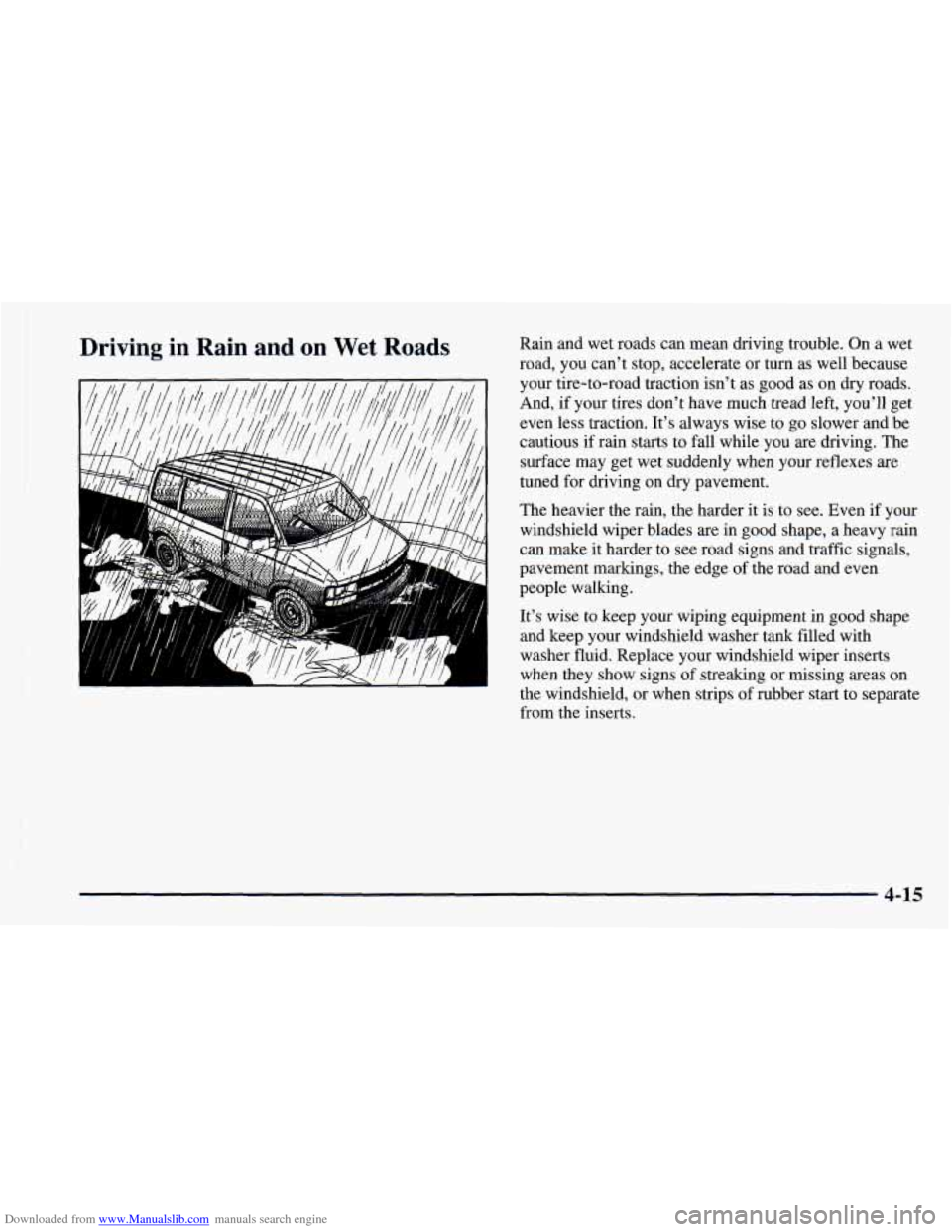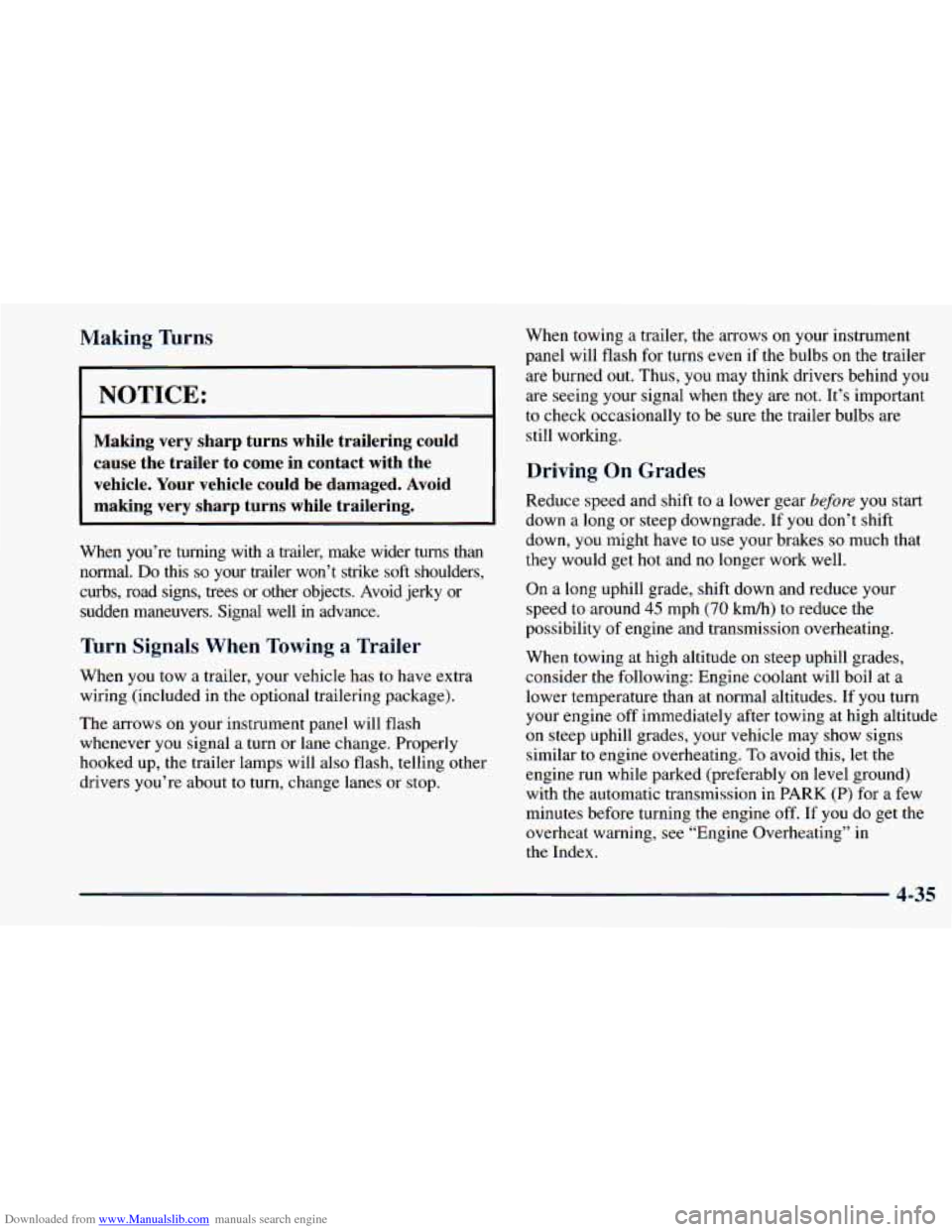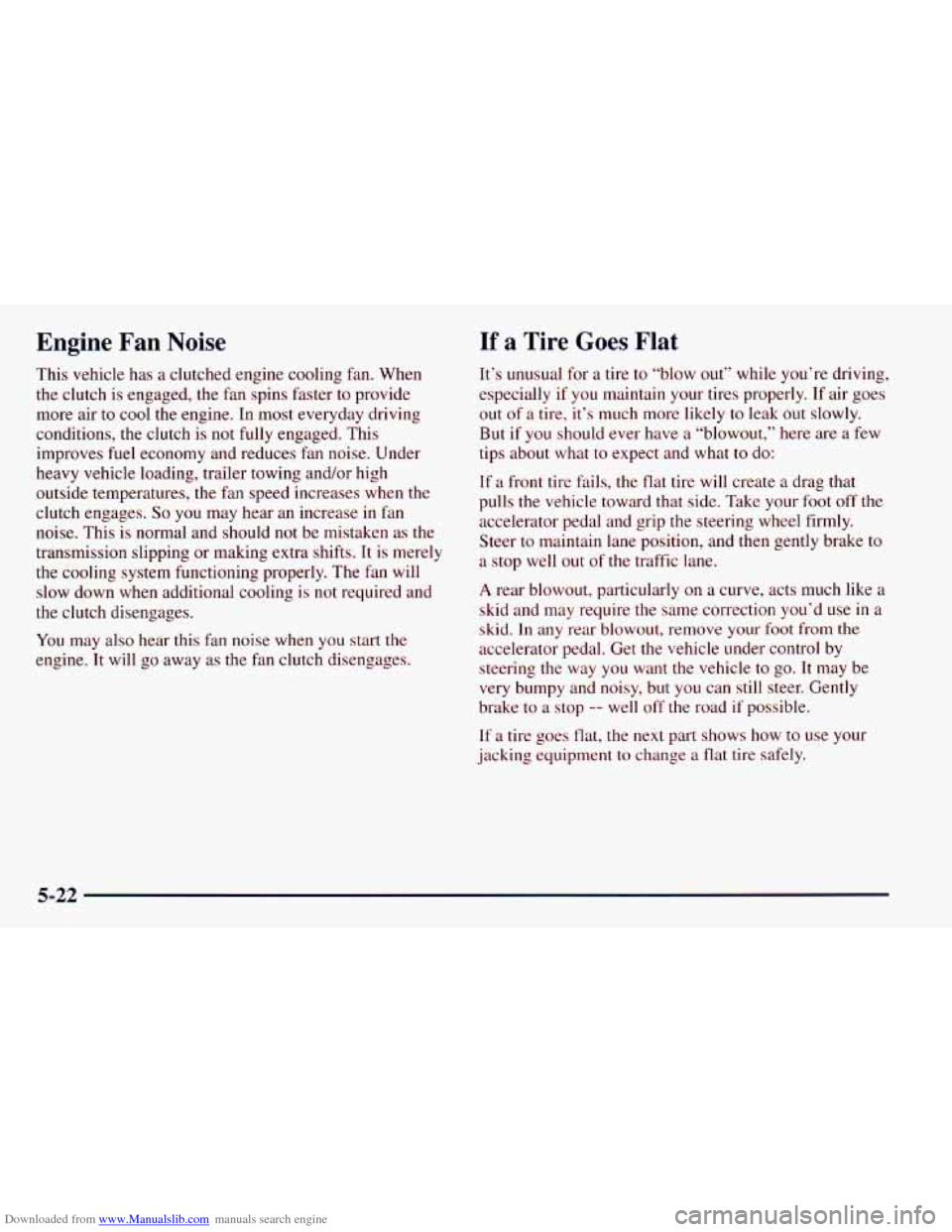1998 CHEVROLET ASTRO stop start
[x] Cancel search: stop startPage 199 of 414

Downloaded from www.Manualslib.com manuals search engine I
Driving in Rain and on Wet Roads Rain ana wet roads can mean driving trouble. On a wet
road, you can’t stop, accelerate or turn as well because
your tire-to-road traction isn’t as good as on
dry roads.
And, if your tires don’t have much tread left, you’ll get
even less traction. It’s always wise to
go slower and be
cautious if rain starts
to fall while you are driving. The
surface may get wet suddenly when your reflexes are
tuned for driving on dry pavement.
The heavier the rain, the harder it is to see. Even if your
windshield wiper blades are in good shape, a heavy rain
can make it harder to see road signs and traffic signals,
pavement markings, the edge of the road and even
people walking.
i
K,
It’s wise to keep your wiping equipment in good shape
and keep your windshield washer tank filled with
washer fluid. Replace your windshield wiper inserts
when they show signs
of streaking or missing areas on
the windshield, or when strips
of rubber start to separate
from the inserts.
4-15
Page 203 of 414

Downloaded from www.Manualslib.com manuals search engine The most important advice on freeway driving is: Keep
up with traffic and keep
to the right. Drive at the same
speed most of the other drivers are driving. Too-fast or
too-slow driving breaks a smooth traffic flow. Treat the
left lane
on a freeway as a passing lane.
At the entrance, there is usually a ramp that leads to the
freeway.
If you have a clear view of the freeway as you
drive along the entrance ramp, you should begin
to
check traffic. Try to determine where you expect to
blend with the flow. Try to merge into the gap at close to
the prevailing speed. Switch
on your turn signal, check
your mirrors and glance over your shoulder as often as
necessary. Try to blend smoothly with the traffic flow.
Once you are on the freeway, adjust your speed to the
posted limit or to the prevailing rate if it’s slower. Stay
in the right lane unless
you want to pass.
Before changing lanes, check your mirrors. Then use
your turn signal.
Just before
you leave the lane, glance quickly over your
shoulder to make sure there isn’t another vehicle in your
“blind” spot.
Once
you are moving on the freeway, make certain you
allow a reasonable following distance. Expect to move
slightly slower
at night. When
you want
to leave the freeway, move to the proper
lane well in advance. If you miss your exit, do not,
under any circumstances, stop and back up. Drive
on to
the next exit.
The exit ramp can be curved, sometimes quite sharply.
The exit speed is usually posted.
Reduce your speed according
to your speedometer, not
to your sense of motion. After driving for any distance
at higher speeds,
you may tend to think you are going
slower than
you actually are.
Before Leaving on a Long Trip
Make sure you’re ready. Try to be well rested. If you
must start when you’re not fresh
-- such as after a day’s
work
-- don’t plan to make too many miles that first part
of the journey. Wear comfortable clothing and shoes
you
can easily drive in.
Is your vehicle ready for a long trip? If you keep it
serviced and maintained, it’s ready to go. If it needs
service, have it done before starting out. Of course,
you’ll find experienced and able service experts in GM
dealerships all across
North America. They’ll be ready
and willing to help
if you need it.
Page 209 of 414

Downloaded from www.Manualslib.com manuals search engine Tie a red cloth to your vehicle to alert police that
you’ve been stopped by the snow.
Put on extra clothing or wrap a blanket around you.
If you have no blankets or extra clothing, make body
insulators from newspapers, burlap bags, rags, floor
mats
-- anything you can wrap around yourself or
tuck under your clothing
to keep warm.
Sr Y can trap exha. ler your vehicle.
~ This can cause deadly 60 (carbon monoxide) gas
to get inside. CO could overcome you and kill
you.
You can’t see it or smell it, so you might not
know
it is in your vehicle. Clear away snow from
around the base of your vehicle, especially any
~ that is blocking your exhaust pipe. And check
around again from time to time to be sure snow
doesn’t collect there.
Open a window just
a little on the side of the
vehicle that’s
away from the wind. This will help
~ keep CO out.
Run your engine only as long as you must. This saves
fuel. When you run
the engine, make it go a little faster
than just idle. That is, push the accelerator slightly. This
uses less fuel for the heat that you get and it keeps the
battery charged. You will need a well-charged battery
to
restart the vehicle, and possibly for signaling later on
with your headlamps. Let
the heater run for a while.
You can run the engine to keep warm, but be careful.
4-25
Page 219 of 414

Downloaded from www.Manualslib.com manuals search engine Making Turns
NOTICE:
Making very sharp turns while trailering could cause the trailer
to come in contact with the
vehicle.
Your vehicle could be damaged. Avoid
making very sharp turns while trailering.
When you’re turning with a trailer, make wider turns than
normal. Do this so your trailer won’t strike soft shoulders,
curbs, road signs, trees or other objects. Avoid jerky or
sudden maneuvers. Signal well
in advance.
Turn Signals When Towing a Trailer
When you tow a trailer, your vehicle has to have extra
wiring (included in the optional trailering package).
The arrows on your instrument panel will flash
whenever you signal a turn or lane change. Properly
hooked
up, the trailer lamps
drivers you’re about to turn, will
also flash, telling other
change lanes or stop. When
towing a trailer, the arrows on your instrument
panel will flash
for turns even if the bulbs on the trailer
are burned out. Thus, you may think drivers behind you
are seeing your signal when they are not. It’s important
to check occasionally to be sure the trailer bulbs are
still working.
Driving On Grades
Reduce speed and shift to a lower gear before you start
down a long or steep downgrade. If you don’t shift
down, you might have to use your brakes
so much that
they would get hot and no longer work well.
On a long uphill grade, shift down and reduce your
speed
to around 45 mph (70 kdh) to reduce the
possibility of engine and transmission overheating.
When towing
at high altitude on steep uphill grades,
consider the following: Engine coolant will boil at a
lower temperature than at normal altitudes. If you turn
your engine off immediately after towing at high altitude
on steep uphill grades, your vehicle may show signs
similar to engine overheating.
To avoid this, let the
engine
run while parked (preferably on level ground)
with the automatic transmission in
PARK (P) for a few
minutes before turning the engine off. If you do get the
overheat warning, see “Engine Overheating” in
the Index.
4-35
Page 220 of 414

Downloaded from www.Manualslib.com manuals search engine Parking on Hills
You really should not park your vehicle, with a trailer
attached,
on a hill. If something goes wrong, your rig
could start
to move. People can be injured, and both
your vehicle and
the trailer can be damaged.
But if you ever have
to park your rig on a hill, here’s
how to do
it:
1. Apply your regular brakes, but don’t shift into
2. Have someone place chocks under the trailer wheels.
3. When the wheel chocks are in place, release the
regular brakes until the chocks absorb the load.
4. Reapply the regular brakes. Then apply your parking
brake, and shift to
PARK (P).
5. Release the regular brakes.
PARK (P) yet.
When You Are Ready to Leave After
Parking on a Hill
1. Apply your regular brakes and hold the pedal down
while
you:
0 Start your engine;
Shift into a gear; and
Release the parking brake.
2. Let up on the brake pedal.
:ks.
3. Drive slowly until the trailer is clear of the choc
4. Stop and have someone pick up and store the chocks.
Maintenance When Trailer Towing
Your vehicle will need service more often when you’re
pulling a trailer. See the Maintenance Schedule for more
on this. Things that are especially important in trailer
operation are automatic transmission fluid (don’t
overfill), engine oil, axle lubricant, belt, cooling system
and brake adjustment. Each
of these is covered in this
manual, and the Index will help
you find them quickly.
If you’re trailering, it’s a good idea
to review these
sections before you start your trip.
Check periodically to see that all hitch nuts and bolts
are tight.
4-36
Page 244 of 414

Downloaded from www.Manualslib.com manuals search engine Engine Fan Noise
This vehicle has a clutched engine cooling fan. When
the clutch is engaged, the fan spins faster to provide
more air to cool the engine. In most everyday driving
conditions, the clutch is not
fully engaged. This
improves fuel economy and reduces fan noise. Under
heavy vehicle loading, trailer towing andor high
outside temperatures, the fan speed increases when the
clutch engages.
So you may hear an increase in fan
noise. This is normal and should not be mistaken
as the
transmission slipping or making extra shifts. It is merely
the cooling system functioning properly. The fan will
slow down when additional cooling
is not required and
the clutch disengages.
You may also hear this fan noise when you start the
engine. It will go away
as the fan clutch disengages.
If a Tire Goes Flat
It’s unusual for a tire to “blow out” while you’re driving,
especially
if you maintain your tires properly. If air goes
out of
a tire, it’s much more likely to leak out slowly.
But
if you should ever have a “blowout,” here are a few
tips about what to expect and what
to do:
If a front tire fails, the flat tire will create a drag that
pulls the vehicle toward that side. Take your foot off
the
accelerator pedal and grip the steering wheel firmly.
Steer
to maintain lane position, and then gently brake to
a stop well out of the traffic lane.
A rear blowout, particularly on a curve, acts much like a
skid and may require the same correction you’d use in a
skid. In any rear blowout, remove your foot from the
accelerator pedal. Get the vehicle under control by
steering the way you want the vehicle to go. It may be
very bumpy and noisy, but you can still steer. Gently
brake to
a stop -- well off the road if possible.
If
a tire goes flat, the next part shows how to use your
jacking equipment to change a flat tire safely.
5-22
Page 324 of 414

Downloaded from www.Manualslib.com manuals search engine / 18 24
5 11 17 23 c7 c7 c7 17
4 ~ 10 16
3 9 15 21 c7 E7 c7 E7
2 8 14 20 c7 c7 11 17
7 13 19 E7 c7 c7 E3
FuseKircuit
Breaker Usage
4
8
9
2
3
FuseKircuit Breaker
Usage I
1 Stop/Turn/Hazard Lamps, CHMSL,
! Chime Module
Not Used
Courtesy Lamps, Power Outside
Mirrors, Glove
Box Lamp, Dome
Reading Lamps, Vanity Mirror Lamps
10
11
DRL Relay, DRL Module, Chime
Headlamp Switch, Keyless Entry,
Cluster, Overhead Console, Interior
Lamps Module
Not Used
Cruise Module, Cruise Control Switch
Power Outlets, DLC, Subwoofer
Amplifier Starter Enable Relay
I
License Plate Lamp, Taillamps, I
Parking Lamps, Ashtray Lamp, Panel
Lights, Trailer Taillamps, Front and
Rear Sidemarker Lamps, Door Switch
Illumination, Headlamp Switch
Illumination, Rear Seat Audio
Illumination
Air
Bag System
Wiper Motor, Washer Pump, Upfitter
Relay Coil
Page 327 of 414

Downloaded from www.Manualslib.com manuals search engine Fuse/Circuit Breaker Usage
UPFIT-BATT Upfitter Battery Power Stud, Trailer
UPFIT-ACCY Upfitter Accessory Relay
Wiring
Harness
Spare
Fuse Puller*
Spare
Spare
ECM-B
HORN
A/C COMP
RR DEFOG
ENG-I
Fuse/Circuit Breaker Usage
IGN-E
ECM-I
Not used
LIGHTING
Not used
Not used Fuel Pump Relay and Motor, VCM,
Oil Pressure Switch/Sender
Horn Relay and Horn
A/C Enable Relay and Compressor
Heater-A/C Control Selector Switch,
Rear Window Defogger
Oxygen Sensors, Camshaft Position
Sensor, Mass Air Flow Sensor,
Evaporative Emission Canister Purge
Solenoid, Linear EGR Valve
Solenoid, VCM EGR HI BATT
IGN A
IGN B
ABS
NC
RR HTRIAC
Spare A/C
Enable Relay Coil
Fuel Injectors
1-6, Crankshaft
Position Sensor, VCM, Coil Driver
Module (EST)
Park Lamps Fuse, DRL Fuse,
Headlamp and Panel Dimmer Switch
SteeringBecurity Fuse, Courtesy
Fuse, ACSY CB, Stop/Hazard Fuse,
Auxiliary Power Fuse, Cigar Lighter
Fuse, Radio Battery Fuse
Starter Relay, Ignition Switch
Ignition Switch
Electronic Brake Control Module Blower Motor Resistor, Blower
Relay
Auxiliary Heater NC Relay
Not used
*A fuse puller is included
in the underhood electrical
center. You will also find spare fuses.
6-65